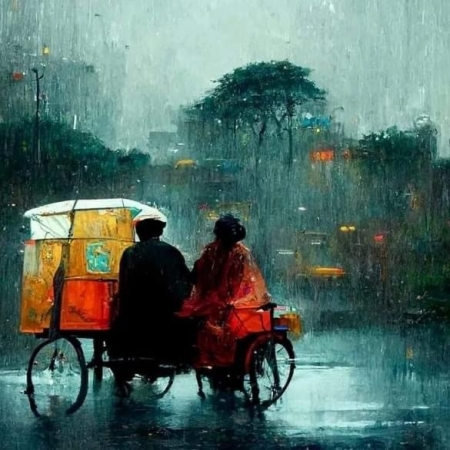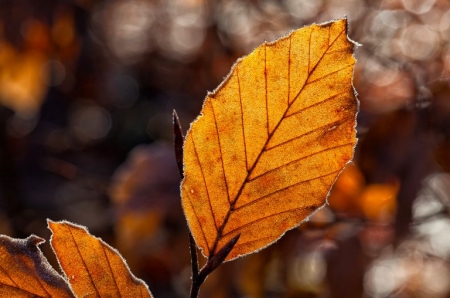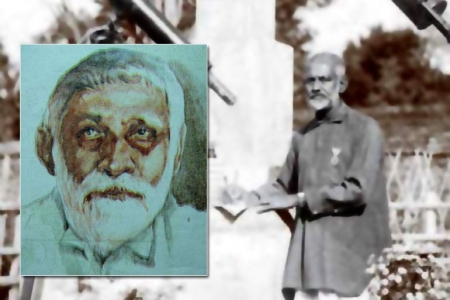
সময়টা ১৯০০ সাল । যশোর শহরে আইনজীবী কালীনাথ মুখোপাধ্যায়ের বৈঠক খানায় চলছে সান্ধকালীন আড্ডা । শহরের মান্য গন্য আইনজীবী ও বিভিন্ন পেশার লোক প্রতি সন্ধ্যায় মিলিত হন কালীনাথের এই আড্ডায় । পেশায় আইনজীবী হলেও কালীনাথ একজন সৌখিন জ্যোতির্বিদ । এর মধ্যে অনুবাদ করে ফেলেছেন সংস্কৃত খগোল চিত্রম এর বাংলা অনুবাদ “তারা” আর লিখে ফেলেছেন আরো একটি বই ‘ Popular Hindu Astronomy “. শহরের এই সব গন্য মান্য ব্যাক্তির সান্ধকালীন আড্ডায় , যশোর কালেক্টরেট অফিসের এক ছাপোষা কেরানী , সারাদিন চাকরি শেষে কালীনাথের কাছে আসেন আকাশের জ্যোতিষ্ক , নক্ষত্র মণ্ডলী নিয়ে সামান্য আলোচনা করতে , অভিজ্ঞতা আদান প্রদানের উদ্দেশ্যে । থাকেন শহর থেকে দূরে বকচর গ্রামে । এই দরিদ্র কেরানীকে কালীনাথ সাহায্য করেছিলেন জ্যোতির্বিজ্ঞান বিষয়ক বই পত্র দিয়ে , তিনি তখনো ভাবতেই পারেন নি , এই কেরানী একদিন হয়ে উঠবে বাংলাদেশে পরজবেক্ষন জ্যোতির্বিজ্ঞানের জনক , হয়ে উঠবে বাংলার সৌখিন জ্যোতির্বিদদের আরাধ্য , বাংলার গ্যালিলিও । তৎকালীন ব্রিটিশ কালেক্টরেট অফিস যশোরের এই কেরানীর গল্পই আজ আপনাদের করবো।
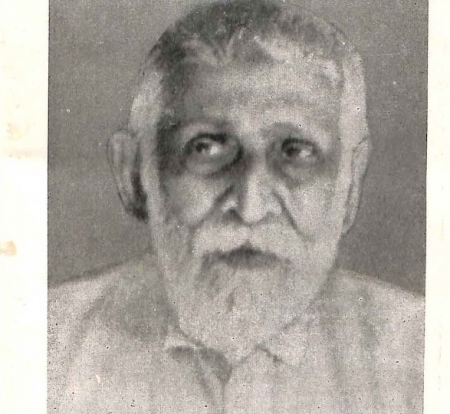
তাঁর নাম রাধাগোবিন্দ চন্দ্র।বাংলাদেশে পর্যবেক্ষণ মুলক জ্যোতির্বিজ্ঞান এর শুভ সুচনা , তাঁর মতো সৌখিন জ্যোতির্বিদ এর হাতে ধরে হয়েছিল । আমাদের বুঝতে হবে , পর্যবেক্ষণ মুলক জ্যোতির্বিজ্ঞান কি ? জ্যোতির্বিজ্ঞানের এই শাখায় পাকাপোক্ত হতে হলে , শুধু তত্ত্বীয় বই পরলে চলে না , বইয়ের পাশাপাশি আকাশে দেদিপ্যমান নক্ষত্র মণ্ডলীর গতিবিধি সম্পর্কে নিয়মিত নজর রাখতে হয় , পর্যবেক্ষণ করতে হয় খ বস্তুদের , হোক সেটা খালি চোখে , বাইনোকুলারের মাধ্যমে , কিংবা টেলিস্কোপের সাহাজ্য নিয়ে । শিশু বয়স থেকেই রাধা রাতের আকাশের সঙ্গী ছিলেন। তারারা তাঁকে ঘুম পাড়িয়েছে। তারারা তাঁর ঘুম ভাঙ্গিয়েছে। রাধা যখন ষষ্ঠ শ্রেণীর ছাত্র ছিলেন তখন তাঁর পাঠ্যপুস্তক ছিল ‘চারুপাঠ তৃতীয় ভাগ’। এই বইয়ে অক্ষয়কুমার দত্তের প্রবন্ধ ‘ব্রহ্মান্ড কি প্রকান্ড’ পাঠ করেই রাধাগোবিন্দ জ্যেতির্বিজ্ঞানী হওয়ার স্বপ্ন দেখেছিলেন। তারা কি, গ্রহ কি, বিশ্বের সীমানা কি, এসব নানাবিধ প্রশ্ন তখন তাঁর মনে। তিনি তাঁর আত্নজীবনীমূলক পান্ডুলিপিতে এ সম্পর্কে লিখেছেন, ‘অক্ষয় কুমার দত্তের চারুপাঠ তৃতীয় ভাগ পড়িয়া, নক্ষত্রবিদ হইবার জন্যে আর কাহারো বাসনা ফলবর্তী হইয়াছিল কিনা জানি না, আমার হইয়াছিল। সেই উদ্দাম ও উশৃঙ্খল বাসনার গতিরোধ করিতে আমি চেষ্টা করি নাই।”
অদম্য ইচ্ছা যে মানুষকে কোথায় নিয়ে যেতে পারে এই পর্যবেক্ষণ মূলক জ্যোতির্বিজ্ঞানী রাধা গোবিন্দ চন্দ্র তার উৎকৃষ্ট প্রমান । চারবার ম্যাট্রিক ফেল এই বিজ্ঞানীর জীবন দেখে বোঝা যায় কেবল প্রাতিষ্ঠানিক শিক্ষা ব্যাবস্থা যথার্থ বিজ্ঞান মনস্কতা তৈরি করতে পারে না ।
রাধাগোবিন্দের আত্মজীবনী তে তিনি বলেছেন “শেষবার মেট্রিকুলেশন পরীক্ষায় অকৃতকার্য হইয়া বিদ্যালয় পরিত্যাগ করিলাম , কিন্তু অধ্যয়ন পরিত্যাগ করি নাই । “ হ্যাঁ ইচ্ছে , শুধু ইচ্ছের উপর নির্ভর করেই রাধাগোবিন্দ হয়ে উঠেছিলেন সে যুগের মানে পরাধীন ভারত বর্ষের বিশ শতকের গোড়ার দিকে একজন শ্রেষ্ঠ স্ব –শিক্ষিত । ১০ বছর বয়সে রাধাগোবিন্দ চন্দ্র যশোর জিলা স্কুলে ভর্তি হন। এ সময় থেকেই বকচরের একতলা বাড়ির ছাদে সন্ধ্যার পর পরই রাধা আকাশ দেখা শুরু করেন। কিন্তু প্রাথমিকভাবে এ কাজে তাঁকে বেশ বেগ পেতে হয়েছে। কেননা নক্ষত্র গ্রহ সম্পর্কে তাঁর খুব বেশী ধারণা ছিল না। একান্তভাবে, নিজের চেষ্টায় বকচর গ্রামের ১৪ বছরের কিশোর রাতের আকাশের তারামন্ডলীকে চিনে ফেললো। এমনও রাত গেছে তিনি ঘুমাননি একটুও। চতুর্থ বার ম্যাট্রিকুলেসন ফেল করে তিনি যশোর জেলা কালেক্টর অফিসে পিয়নের চাকরি নেন । অফিস করে নিজ গ্রাম বকচরে ফেরার পথে তিনি নিয়মিত যাতায়াত করতেন এই বিষয়ে তাঁর গুরু ব্যারিস্টার কালীনাথ মুখোপাধ্যায় এর সান্ধকালীন আড্ডায় । এই ব্যারিস্টার কালীনাথ মুখপাধ্যায় লন্ডনে থাকাকালীন , ইউরেনাস গ্রহের আবিষ্কারক উইলিয়াম হারসেলের ছেলের বন্ধু ছিলেন এবং বন্ধুর হাত ধরেই তাঁর জ্যোতির্বিজ্ঞানে হাতেখড়ি । কালীনাথ ভারতবর্ষে পৌঁছেই লিখে ফেলেন তৎকালীন সময়ে দুটো কালজয়ী জনপ্রিয় পর্যবেক্ষণ মুলক জ্যোতির্বিজ্ঞানের বই “খগোল চিত্রম” এবং Popular Hindu Astronomy । কালীনাথের কাছ থেকে পাওয়া এই বই দুটি বিশেষ করে খগোল চিত্রম বইটি রাধাগোবিন্দের পর্যবেক্ষণ এর গতি আরো বাড়িয়ে দেয় ।
রাধাগোবিন্দ ও ধুমকেতুঃ
হ্যালির ধুমকেতুঃ অবশেষে বাংলার আকাশে মইউর পুচ্ছের মত ইয়া বড় এক লেজ নিয়ে হাজির হল হ্যালির ধুমকেতু । সময়টা ২৫ এ আগস্ট ১৯০৯ । রাধা গোবিন্দ প্রবল উৎসাহে হ্যালির ধুমকেতু পর্যবেক্ষণ করতে লাগলেন । ঠিক ওই সময় যশোরের রায় বাহাদুরের মাধ্যমে রাধাগোবিন্দের সাথে পরিচিত হন তৎকালীন বিশ্বভারতীর বিজ্ঞান শিক্ষক “প্রবাসী” পত্রিকার সম্পাদক জগদানন্দ রায় এর সাথে । তার মাধ্যমে তিনি একটি বাইনোকুলার হাতে পান । ওই সময় ভারতের বেশ কয়েকজন জ্যোতির্বিদ , ভারতে আকাশে হ্যালির ধুমকেতুর আসল অবস্থান জানার চেষ্টা করছিলেন , কিন্তু কোন সঠিক অবস্থান গননা করে নির্ণয় করতে পারছিলেন না । কিন্তু রাধাগোবিন্দের পর্যবেক্ষণ লব্ধ ফলাফল দেখাচ্ছিল হ্যালির ধুমকেতুর লেজটার অবস্থান অনেকটা শুক্র গ্রহের কাছাকাছি । রাধাগোবিন্দ তাঁর পর্যবেক্ষণ লব্ধ ফলাফল , জগদানন্দ রায় এর মাধ্যমে ওই সময়কার আরেকজন জ্যোতির্বিদ John Evershed (1864 - 1956), এর কাছে পাঠিয়ে দেন এবং আশ্চর্য জনক ভাবে দেখা গেল রাধা গোবিন্দের গণনাই সঠিক ।
এই প্রসঙ্গে হালের গবেষক অমলেন্দু বন্দ্যোপাধ্যায় তার একটা গবেষণা পত্রে লেখেন "A report on his observation of the comet 1P/Halley was recorded by Chandra in his book entitled ‘Dhumketu’ (The Comet). At that time Rai Bahadur Jadunath Majumder, Vedanta Bachaspati, M. A., B. L., C. I. E. was the most revered person of Jessore. Rai Bahadur inspired the people of the town so much that they became very enthusiastic for the observation of predicted apparition of the comet. By then, Chandra had no adequate experience for such observation. Even he had no sky atlas except the ‘Bhagola Charitam’ prepared by Mukherjee. But, fortunately he received some guidance from the two articles on the subject, published in the ‘Probasi’, a Bengali monthly magazine and authored by Jagadananda Roy (1869 - 1933). Jagadananda was a renowned science teacher of the school at Santiniketan under Viswabharati University, Bolpur founded by the Nobel Laureate poet Rabindranath Tagore (1861 - 1941) who supplied a 4-inch telescope to Jagadananda for observation of the comet 1P/Halley. By making personal contact, Chandra wanted to know the predicted time and location of the forthcoming comet from Roy who promptly fulfilled his request. By the guidance of the latter Chandra became one of the first observers to locate the comet 1P/Halley from India on 24 April 1910 with the help of his binocular. He spotted the comet for the first time as a small star-like object slightly below the Venus and to the south of the star γ Pegasi2 . The comet’s tail was scheduled 1 1 A. U. = 149597870 km. 4 to occult the Venus on May 2 1910, but Chandra didn’t observe the occultation although the Venus was seen juxtaposed near the tail. He speculated that the transient part of the tail was lying on the Venus and hence the occultation was not visible. Afterwards, photograph of the comet 1P/Halley taken by John Evershed between 4.40h and 5.10h IST revealed that the transient part of the cometary tail was indeed lying on the Venus. This proves the high quality of intuition possessed by the self-taught astronomer Chandra. However, he observed the comet in its full bloom for the first time on May 10 at 3.20h IST. According to him2 , the tail was passing through the north of γ Aquarii, west of α Aquarii, north of β Aquarii and south of ǫ Pegasi. He observed some small stars through the tail to the north of γ and β Piscium. The head of the comet was lying in the second part of Pisces and the tail was extended to the last portion of Capricornus. He continued his observations on the comet which was not visible by naked eyes, maintaining exchange of experiences with Roy of Santiniketan (230 39′ N, 870 43′ E) and John Evershed (1864 - 1956), the Evershed effect discoverer, of Kodaikanal Observatory (100 14′ N, 770 28′ E)3 . Chandra kept his vigilant eyes on the comet 1P/Halley, 1909 R1 and subsequently published two articles in details on its apparition as observed by him. Roy was very much impressed by reading those articles and advised him to procure a telescope in order to have better observations in future on the celestial objects. The former already felt very much the need of such an optical instrument and so his feeling was vigorously inspired by the advice of the latter
হ্যালির ধুমকেতুর উপর রাধাগোবিন্দের পর্যবেক্ষণ দুটো লেখার মাধ্যমে তৎকালীন “প্রবাসী” পত্রিকায় প্রকাশিত হয় । এর পর রাধাগোবিন্দ হ্যালির ধুমকেতুর উপর তার পর্যবেক্ষণ নিয়ে বাংলায় “ধূমকেতু” নামে ১৯১২ সালে একটি গ্রন্থ প্রকাশ করেন , যা তৎকালীন বিদ্যত সমাজে নাড়া ফেলে দিয়েছিল । পাঠক , একটু ভাবে দেখুন , কোন একাডেমিক ডিগ্রি না থেকেও , ওই সময় এই ধরনের একটা গবেষনা ধর্মী বই বের করা চাট্টিখানি কথা নয় ।
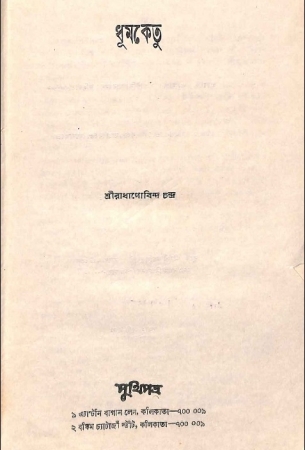
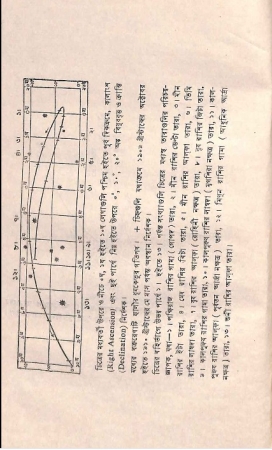
এই ধুমকেতু বইটা উনি শেষ করেছিলেন এইভাবে “ ৮ ই জুলাই ২৪ এ আষাঢ় শুক্রবার , আমরা হ্যালির ধুমকেতুকে বাইনোকুলারে দেখিয়া শেষ বিদায় অভিনন্দন জ্ঞ্যাপন করিলাম । আমরা এ জীবনে উহাকে আর দেখিবো না , ৭৬ বছর পরে , ১৯৮৬ খ্রিস্টাব্দের ফেব্রুয়ারি মাসে , আমাদের বংশধরদের নয়নপথে হয়তো আর এক বিভীষিকাময়ী মূর্তিতে আবির্ভূত হইয়া আতঙ্কের সঞ্চার করিবে । আমার জীবনে এই সৌভাগ্য হয়েছে , ১৯৯৬ মহসিন কলেজের পাহার থেকে বাইনোকুলারের মাধ্যমে এই বিস্ময় হ্যালির ধুমকেতুকে উপভোগ করেছিলাম ।
১৯১২ সালের দিকে রাধাগোবিন্দ তাঁর বেতনের টাকা ও খানিকটা জমি বিক্রির টাকা দিয়ে একটি দুরবিন সংগ্রহ করেন। এটি ৩ ইঞ্চি ব্যাসের একটি প্রতিসরণ দুরবিন ছিল। ১৯১২ সালের সেপ্টেম্বর মাসে দুরবিনটি ইংল্যান্ডের F. Bernard থেকে মেসার্স কক্স সিপিং এজেন্সি লিমিটেড এর মাধ্যমে রাগাগোবিন্দের কাছে আসে। রাধাগোবিন্দকে খুব হিসেব করে চলতে হত। সাংসারিক খরচের দ্বায়িত্ব থেকে আকাশ চর্চায় যা ব্যয় হত তা তিনি লিখে রাখতেন। সম্পূর্ণ দুরবিনটি দাম পড়েছিল ১৬০টাকা ১০ আনা ৬ পাই। এই হিসেবটি তাঁর খাতায় লেখা ছিল। প্রথমে মূল দুরবিনটির টিউব ছিল কার্ডবোর্ডের তৈরি। পরে তিনি আরও ৯৬ টাকা ১০ আনা খরচ করে ইংল্যান্ডের মেসার্স ব্রহহার্স্ট এণ্ড ক্লার্কসন থেকে পিতলের টিউব আনিয়ে নেন এবং দুরবিনটির উন্নতি সাধন করেন। রাধাগোবিন্দের নথিপত্রে তাঁর নিজের হাতের লেখায় তিনি লিখে গেছেন:
“সন ১৩১৯ সালের আশ্বিন মাসে দুরবিন আসার পরে রাধাগোবিন্দ চন্দ্রের নক্ষত্রবিদ্যা অনুশীলনের ৪র্থ পর্ব আরম্ভ। এই সময়ে তিনি কালীনাথ মুখোপাধ্যায়ের ‘ভগোলচিত্রম’ ও ‘তারা’ পুস্তকের সাহায্যে এটা-ওটা করিয়া যুগল নক্ষত্র, নক্ষত্র-পুঞ্চ নীহারিকা, শনি, মঙ্গল প্রভৃতি গ্রহ দেখিতেন। পরে জগদানন্দ রায়ের উপদেশ মত স্টার অ্যাটলাস এবং ওয়েব’স সিলেসিয়াল অবজেক্ট ক্রয় করিয়া যথারীতি গগন পর্যবেক্ষণ করিতে আরম্ভ করেন। কিন্তু ইহাতেও তাঁহার কার্য্য বেশীদূর অগ্রসর হয় নাই। তবে তিনি এই সময়ে গগনের সমস্তরাশি নক্ষত্র ও যাবতীয় তারা চিনিয়া লইয়াছিলেন এবং কোন নির্দিষ্ট তারায় দুরবিন স্থাপনা করিতে পারিতেন।”
এর পর তিনি আরো একটি ধুমকেতু পর্যবেক্ষণ করেছিলেন এই সম্পর্কে শৈবাল রায়ের একটি গবেষণা পত্রে পাওয়া যায় Chandra observed the comet 7P/P ons − W innecke 1927, which remained visible from 25 5 February 1927 to 10 January 1928 and passed the perihelion distance of 1.039235 A. U. on 21 June 1927 at about 1h 34m 10.56s U. T. On 20 June 1927 at about 15.5 h U. T. (21h IST), he was busy with his usual scheduled programme for observations of variable stars. He suddenly noticed a nebula-like object just North-West of the bright star Vega. At that time the comet was visible on the line joining star γ Draconis and α Lyrae (Vega) and was nearer (RA: 18h 22m 30s , Dec: +400 30′ ) to Vega. After consulting the handbook of British Astronomical Association (BAA), he came to know that the object under his observation was the comet 7P/P ons − W innecke. He observed the comet until 7 July 1927. During the period of his observation, he observed the comet to pass through the constellations Lyra, Cygnus, Vulpecula, Delphinus, Pegasus, Acquarius, Sculptor and Phoenix at a very fast speed of 40, 000 km/hr. In the context “Search for meteors from the Pons-Winnecke Radiant”, the following report was published in the journal ‘Nature’4 : R. G. Chandra of Jessore, India, also reports a fruitless search for meteors in the night of June 25. He states that Prof. Ray of Bolpur saw two meteors radiating from the neighbourhood of θ Bootes. Here, Prof. Ray means Jagadananda Roy of Santiniketan as mentioned earlier. The comet 2P/Encke 1927 having period of 3.30 years, the shortest among the periodic comets, was also observed by Chandra. He searched out the said comet from the constellation Pegasus, following the instruction of A. C. D. Cromlin, the Director of BAA, and made observations until 17 January 1928. According to him2 , he detected the comet Encke in 1928 at 7 PM from Jessore with his 3-inch telescope in the Pegasus as a small nebulosity near the Andromeda galaxy (M31). During the apparition, the comet remained visible from 19 October 1927 to 3 April 1928. Chandra was not equipped with adequate data for determining the location of a known comet. However, he succeeded to locate a long period comet at a position 10 to the south-west of the star θ Ceti on 9 February 1941 with the help of his binocular. The comet remained under his observation until 28 February 1941. However, he could not identify the comet. Most probably it was the long period comet C/1941 B1 F riend − Reese − Honda with a period of 355 years. This comet remained visible from 18 January 1941 to 1 March 1941 as recorded in the Catalogue of Cometary Orbits-1999 (Catalogue 1999). On 24 February 1943, at about 16.5 U. T. (22.00 IST) Chandra was engaged to observe variable stars with absorbed attention. All of a sudden he noticed a nebula-like object near the star γ Ursae Majoris. Later he could recognize the object as a comet. According to Chandra’s observation2 , the position of the comet on that date (24 February 1943) was R. A. 11h 55m, Dec 6 +550 at 10 PM. Its speed was slow and was visible in the east as a third magnitude star. The small tail was only visible through the telescope. He observed it as a bright nebula on the line joining the star δ Ursae Majoris and γ Ursae Majoris and was nearer to the latter one. Though he could not identify the comet, yet it is possible that he might have observed the long period comet C/1942 X1 Whipple-Fedtke-Tevzadze because the ‘Catalogue-1999’ reveals that the lone comet remained visible during the period 17 November 1942 to 1 August 1943 was the comet C/1942 X1. He made serious observations on the comet until 10 May 1943 with the help of two refracting telescopes, one of his own 3-inch and the other 6.25-inch lent him by the American Association of Variable Star Observers (AAVSO). He recorded the apparent path and cometary phenomena of the comet C/1942X1 in details during the period of his observations. He noticed the variations in its brightness by measuring in magnitude scale on two occasions. First, on 8 March 1943, the magnitude of the comet reduced from the 5th to 4th and again, on 16 March 1943 from the 5.5th to 5th. These observations indicated that the cometary brightness instantly increased on those two occasions. Later from the Journal of BAA, Chandra came to know that the comet C/1942X1 was really a variable one. Also he realized from the said Journal that the phenomena of variations in magnitude observed in the comet was due to influence of solar magnetic disturbances during a sunspot maximum. The systematic observations on comet were initiated in 1760 by Charles Messier (1730 - 1817). Until 1999, astronomers all over the world have discovered 1037 individual comets and observed to make 1688 apparitions of these comets. An outstanding observer of comets amongst the contemporary observers from the Indian sub-continent Chandra observed a good number of comets. However, he could not discover any new comet like Elizabeth Roemer (born 1929) who recovered the highest (79) number of periodic comets! The only name of an astronomer from the Indian sub-continent associated with the discovery of a comet and recorded in the ‘Catalogue-1999’ is Manali Kallat Vainu Bappu (1927 - 1982). Bappu jointly discovered the comet C/1949N1 with his teacher Bart Jan Bok (1906 - 1983) and a fellow student G. Newkirk. This comet is known as the comet C/1949 N1 Bappu − Bok − Newkirk.
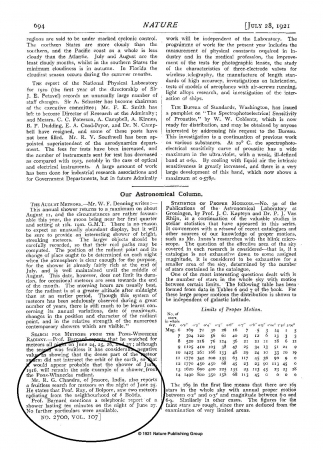
রাধাগোবিন্দ ১৯১৮ সালের জুন ৭ আকাশে একটি উজ্জ্বল নক্ষত্র দেখতে পেলেন যা তার নক্ষত্রের মানচিত্রে ছিল না। তিনি তার এই পর্যবেক্ষণের কথা হাভার্ড মানমন্দিরে জানান এবং এভাবেই নোভা অ্যাকুইলা-৩ ১৯১৮ আবিস্কৃত হয়। তার এই আবিষ্কারের পরই নক্ষত্রের নামকরণ করা হয় ‘নোভা অ্যাকুইলা ত্রি ১৯১৮’। নোভা হচ্ছে কোন তারকার মৃত্যুকালীন অবস্থার বিষ্ফোরণ। সমগ্র এশিয়া মহাদেশে এই নোভা সর্বপ্রথম পর্যবেক্ষণ করার কৃতিত্ব একজন বাঙালির, তিনি হচ্ছেন আমাদের যশোরের কৃতি সন্তান রাধাগোবিন্দ চন্দ্র।
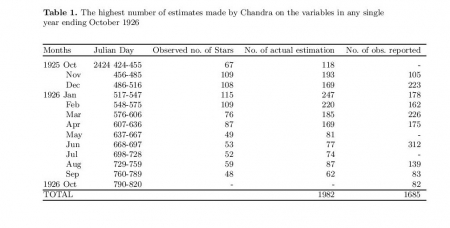
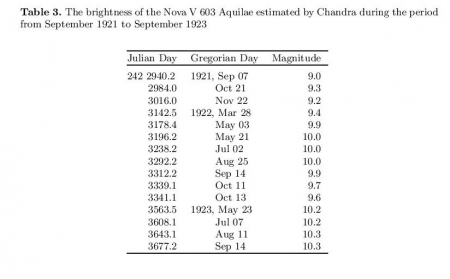
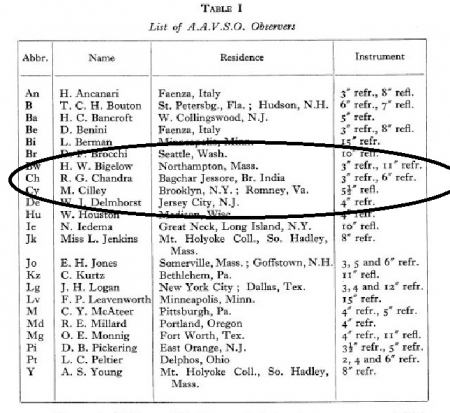
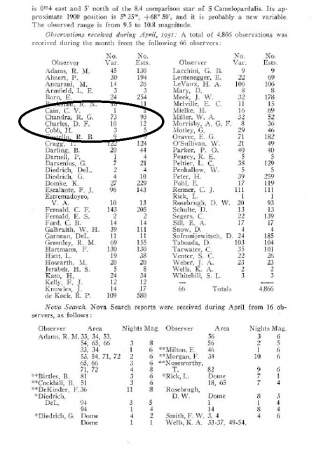
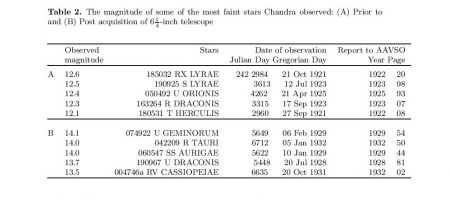
পরে তাকে আমেরিকান এসোসিয়েসন অফ ভেরিয়েবল স্টার অবজারভার (’American Association of Variable Star Observers’(AAVSO)) সম্মানসূচক সদস্যপদ প্রদান করে। ১৯১৯ থেকে ১৯৫৪ এর মধ্যে তিনি ৩৭২১৫টি পরিবর্তনশীল নক্ষত্র পর্যবেক্ষণ করেন এবং এসব তথ্য আভসো (AAVSO)কে প্রদান করেন। এখানে জানতে হবে ভেরিয়েবেল স্টার বা পরিবর্তনশীল তারকারা কি ? অন্য তারাদের থেকে তাদের কেন আলাদা করে বলা হচ্ছে ? বিষমতারা (ইংরেজি: Variable Star) হলো সেই ধরনের নক্ষত্র যাদের পৃথিবী থেকে দেখা উজ্জ্বলতার আপাত মান পরিবর্তনশীল। স্বকীয় বা জ্যামিতিক কারণে উজ্জ্বলতার এই তারতম্য হতে পারে।
তার এওই কার্যক্রমের জন্য তিনি সর্বোচ্চ গুরুত্বপূর্ণ জ্যোতির্বিজ্ঞানী হিসেবে ১৯৪৬ সালে প্রকাশিত আভসোর এক তালিকাভুক্ত হন, যাতে আরও ২৫ জন জ্যোতির্বিজ্ঞানী যারা ১০,০০০ বেশি পরিবর্তনশীল তারা দেখেছেন। এভাবে পাশ্চাত্যের বৃহত্তর বিজ্ঞান-আঙিনায় বাংলার এই জ্যোতির্বিজ্ঞানী আপন কর্মবলে প্রবেশ করলেন। রাধাগোবিন্দই প্রথম এই নোভা প্রত্যক্ষ করেছিলেন। পরবর্তীকালে ‘অ্যাস্ট্রোনমিক্যাল সোসাইটি অব ইন্ডিয়া’র জার্নালে রাধাগোবিন্দের নাম এই নোভার আবিষ্কারক হিসেবে প্রকাশিত হয়।
আভসোর সদস্য হওয়ার পর রাধাগোবিন্দ তিন ইঞ্চি দূরবীন দিয়ে পর্যবেক্ষণ করা তথ্য নিয়মিত তাদের পাঠাতেন। এ সকল পর্যবেক্ষণ তথ্য আভসোর জার্নালে নিয়মিত প্রকাশিত হতো। এর ফলে রাধাগোবিন্দ ইউরোপ ও আমেরিকার অন্যান্য জ্যোতির্বিজ্ঞান সংস্থার সাথে পরিচিত হয়েছিলেন। সংস্থাগুলো তাদের সদস্য হওয়ার জন্য তাঁকে আমন্ত্রণ জানিয়েছিল। পরে রাধাগোবিন্দ ব্রিটিশ অ্যাস্ট্রোনমিক্যাল অ্যাসোসিয়েশন এবং ফ্রান্সের লিঁয় অবজারভেটরির সদস্য হয়েছিলেন।
আভসোতে তিনি ছিলেন একজন গুরুত্বপূর্ণ সদস্য। মাত্র তিন ইঞ্চি ব্যাসের দূরবীন দিয়ে তিনি যে সুনিপুণ পর্যবেক্ষণ করতেন তা ছিল অভাবনীয়। পরবর্তীকালে তাঁর পর্যবেক্ষণের সুবিধার্থে এবং পর্যবেক্ষণ তথ্য শুধু আভসোকেই পাঠাবেন এ শর্তে আভসো তাঁকে ৬.২৫ ইঞ্চির একটি শক্তিশালী প্রতিসরণ দূরবীন ধার দেয়ার ইচ্ছা ব্যক্ত করে। এ প্রস্তাবে রাধাগোবিন্দ অত্যন্ত আনন্দিত হোন। ১৯২৬ সালে আমেরিকার নিউ ইয়র্ক থেকে সুদূর যশোরের পল্লীতে এসে দূরবীনটি পৌঁছায়। সে সময় এই দূরবীনটি ছিল বাংলাদেশের সব চেয়ে বড় দূরবীন।
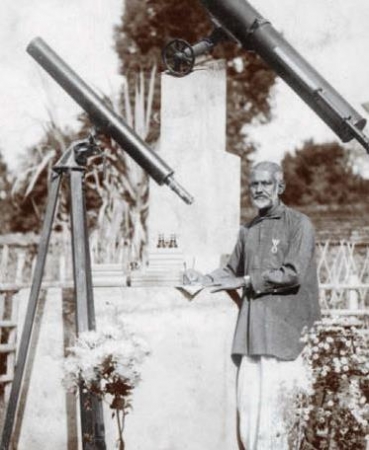
জ্যোতির্বিজ্ঞানী রাধা গোবিন্দো ও তাঁর উপহার পাওয়া ৬.২৫ ইঞ্চির ব্যাসের টেলিস্কোপ
এই ব্যাপারে উৎপল বন্দ্যোপাধ্যায় তার একটি গবেষণা পত্রে দেখিয়েছেনঃ Chandra became interested for making observations on the planets, comets, meteors etc. His interest was so much intense that after the acquisition of a 3-inch telescope, he gradually became 7 an expert observer of variable stars. In course of his routine-wise observation on stars from Bagchar (230 10′ 5 ′′ N, 890 10′ 15′′ E), Chandra had a chance in 1918 to locate a ‘New Star’ which was actually a Nova. It was the time for on setting of rainy season of the year. The light radiating celestial objects were playing hide and seek behind the running clouds of the sky. On the night of 7-8 June 1918, at about 15.5 h U. T. (21.00h IST), he was watching the celestial objects from a wide open place. Suddenly, he noticed that the space around him was inundated with unusually bright but smooth light! Also light with such intensity is visible only when the bright Venus with −4.4 magnitude makes closest approach to the Earth. He could not justify the reason for the appearance of such unique brightness on a night before the New Moon when there was no possibility for the appearance of Moon at the said hours of night. Also, the bright planets such as the Venus and −2.7 magnitude Jupiter were not scheduled to rise above horizon at that time in the night sky. Yet, he was at his wits end to explain the presence of unusual brightness on the landscape at that night. As the sky was infested with passing clouds, he did not intend to make any observation in search of the source of light. Even though, the suspicion that the source of light might be a celestial object was gaining ground in his mind. On the very next night of 8-9 June 1918, which was a New moon night, at about 16.5 h U. T. (22.00 IST), Chandra easily noticed a ‘bright star’ at a glance. But the part of the sky under his observation was covered with a veil of passing clouds. He thought that the ‘bright star’ might be the star Altair, the brightest one of the Aquila constellation. After sometime, the veil of clouds ran away and as a result both the ‘bright star’ and Altair became clearly visible with glare. The ‘bright star’ (RA: 18h 44m 43.48s , Dec: +00 29′ 28.2 ′′), in comparison, appeared to be brighter than both the 0.77 magnitude Altair and 0.03 magnitude Vega. These three stars were located in the same part of the sky. Also, on a few successive nights, he observed the same brilliance of light in the landscape and the ‘bright star’ in the sky. A news about the ‘new star’ in the constellation Acquila was published in ‘The Statesman’ on 12 June 1918. Chandra read the news and realized that it was the same ‘new star’ which he had been observing since 7 June 1918. As it was at the time of early stage of rainy season, the entire sky was covered with clouds causing occasional rain ever since he made his observation on the ‘new star’ in the night of 8-9 June. It is due to this reason he could not have any chance to repeat his observation on the star until 16 June. In the night of 16-17 June 1918, during the interval of 01.00h to 01.50h IST, the sky around the ‘new star’ remained clearly visible. The ‘new star’ by then attained a higher declination close to the Zenith, enabling Chandra to have a 8 good observation. Accordingly, he located the ‘new star’ at the south-west of 4th magnitude star θ Serpentis and north-east of 3th magnitude star η Serpentis. He also estimated the brightness of the same star and found it to be comparable to that of the 0.9 magnitude Antares. The sudden appearance of a ‘new star’ to the naked eyes of Chandra in the night of 7-8 June 1918 from a location where none other observed before him was actually a ‘Nova’ (in Latin the word ‘Nova’ means ‘new’). This ‘new star’ of the constellation Aquila was designated by the astronomers as the Nova Aquilae 1918. Incidentally, it is the first, if not the only one, Nova whose spectrum at the pre-outburst stage had been recorded. From the records it has revealed that it was an A-type blue star of 10.5 magnitude until 5 June 1918 but suddenly its brightness flared up to 6 magnitude after two days on 7 June. Just at the very phase of changing the star of constellation Aquila into a Nova, Chandra was the first, if not the lone, observer to notice the transition phenomenon on the night of 6-7 June 1918 at 21.00h IST from Bagchar. His observation of the ‘new star’ in the following night of 7-8 June at 15.5 h UT, even at a higher brightness of 0.03 magnitude equaling that of Vega, confirmed the Nova formation of the star. Although the star flared up to a maximum of −1.4 magnitude brightness it eluded him due to unfavorable sky condition. A report on the first observation of the ‘new star’ was authored by Chandra in a widely circulated Bengali monthly magazine the ‘Probashi’ in its Sraban (July-August, 1918) issue of the same year. Jagadananda Roy from Santiniketan read this article on the observation of the ‘new star’. Understanding the importance of his observation, Roy advised him to send the report to Edward C. Pickering (1846 - 1919) of the Harvard College Observatory who might appreciate his work and properly ventilate before the astronomical community. Although Chandra was otherwise busy, yet he did not realize the importance of his work, nor did he know the formalities of reporting the discovery of a Nova. Incidentally, he was very late to report the discovery and subsequently missed the credit of becoming the discoverer of the Nova Aquilae 1918 (see APPENDIX II). However, Campbell realized his agony for missing the credit of being the discoverer of the Nova 1918. In a letter dated 24 June 1921, Leon Campbell (1881- 1951), the Chairman of Telescope Committee, AAVSO, encouraged him by writing - “You have taken up the Nova search work in a good spirit, and I hope you may be rewarded some day with a real Nova discovery”.
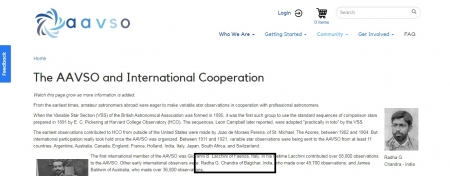
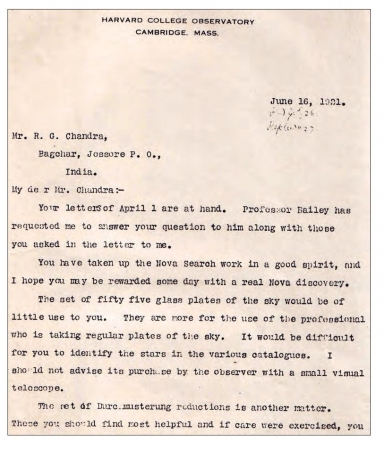
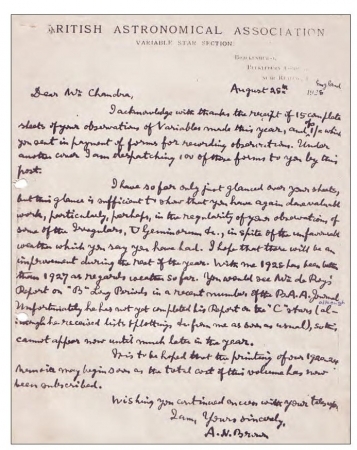
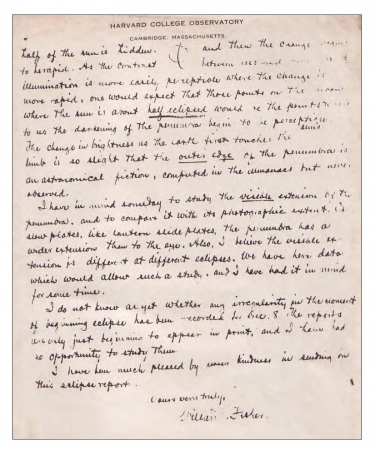
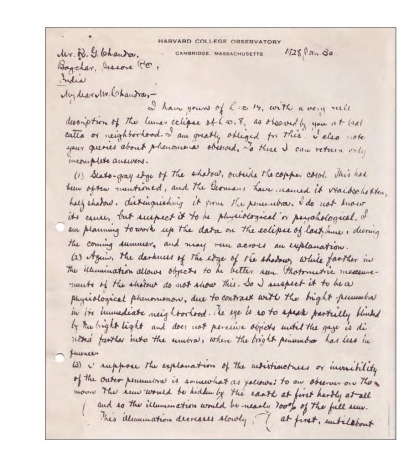
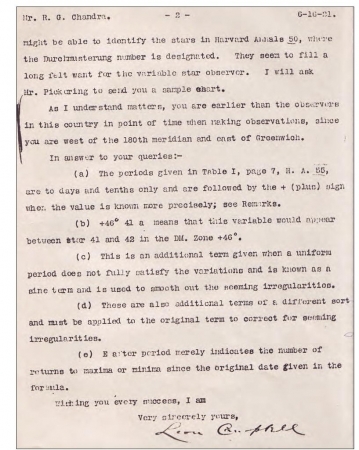
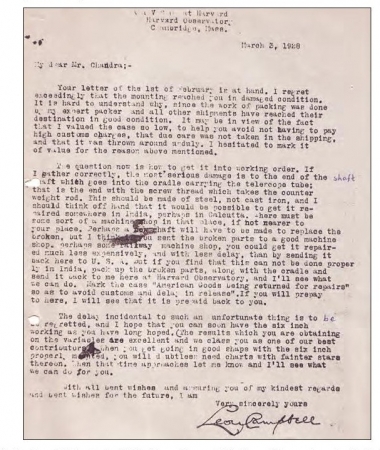
এরপরে ফরাসি সরকার ভ্যারিয়েবল স্টারের উপর তার পর্যবেক্ষণ ও গবেষণার স্বীকৃতি হিসেবে, ১৯২৮ সালে তাকে OARF (Officers Academic republican francaise) সম্মানসূচক উপাধি ও পদক প্রদান করেন। কলকাতায় ফ্রান্সের রাষ্ট্রদূত মারফত তাকে এ সম্মান জানানো হয়। এর আগে কোনো বাঙ্গালি ফ্রান্স সরকারের এমন সম্মান অর্জন করার সৌভাগ্য লাভ করেননি। তাকে সদস্য করে নেয়া হয় Association francaise des Observateurs d’etoiles Variables (AFOEV) এবং ব্রিটিশ এস্ট্রোনমিক্যাল এসোসিয়েশনে। রাধাগোবিন্দের সংগৃহীতের তথ্য সেই কালের ইউরোপ-আমেরিকার যে সব বড় বড় জ্যোতির্বিজ্ঞান সংস্থাগুলো ব্যাবহার করতো তাদের মধ্যে রয়েছে-আমেরিকার হার্ভার্ড বিশ্ববিদ্যালয়ের মানমন্দির, আমেরিকান অ্যাসোসিয়েশন অব ভ্যারিয়েবল স্টার অবজার্ভার, লন্ডনের ব্রিটিশ অ্যাস্টোনমিক্যাল অ্যাসোসিয়েশন, ফ্রান্সের লিয় মানমন্দির প্রভৃতি। হার্ভার্ডে এখনও তাঁর পর্যবেক্ষণ লব্ধ তথ্য সযত্নে রক্ষিত আছে।
Consulate General de la Republique Francaise, Calcutta
Dear Sir, In continuation to my letter dated 26-3-28, I have the honour to inform you that the Ministry of Education has decided to confer upon you the distinction ‘Officer d′Academie’. You will find herein enclosed the Bravet and the badge of this distinction for which I shall be obliged to receive a receipt. I am pleased to convey to you my best congratulations for the token that has been granted to you in recognition of your valuable services to the Observatory of Lyon. Yours faithfully,
R. Lazonies,
Consulate General for France
জ্যোতির্বিজ্ঞান বিষয়ে তিনি অনেক লেখা লিখেছেন। এগুলো প্রকাশিত হয়েছিল তখনকার অনেকগুলো পত্র পত্রিকায়। জ্যোতির্বিজ্ঞানের ওপর চারটি বই লিখেছিলেন তিনি। বইগুলো হল: ধূমকেতু, সৌরজগৎ, সবিতা ও ধরণী এবং নক্ষত্রজগৎ। এর মধ্যে শুধু ধূমকেতু বইটি তাঁর জীবদ্দশায় প্রকাশিত হয়েছিল। অনেক কষ্টে তাঁর এক ভ্রাতুষ্পুত্রের চেষ্টায় বইটি প্রকাশিত হয়। এ বিষয়ে রাধাগোবিন্দ তাঁর ধূমকেতু বইতে লিখেছেন: “দীর্ঘ চারি বৎসরাধিক কাল মুদ্রাযন্ত্রের কুক্ষিগত থাকিয়া আমার প্রথম বৈজ্ঞানিক গ্রন্থ ধূমকেতু লোকলোচনের প্রত্যক্ষীগত হইল। জানি না আমার দেশবাসী কী চক্ষে ইহাকে দেখিবেন, ইহার পরিণতি মুদির দোকানে জিরা-মরিচ বাঁধায় পর্যবসিত হইবে অথবা বঙ্গবাণীর শ্রদ্ধালাভে ধন্য হইবে।”
শেষ জীবনে তিনি তাঁর অপ্রকাশিত অন্য তিনটি বই সম্পর্কে লিখে গেছেন:
“নক্ষত্রবিজ্ঞানের অপর গ্রন্থনিচয় সৌরজগৎ, সবিতা ও ধরণী এবং নক্ষত্রজগৎ মুদ্রণের ব্যবস্থা হয় নাই । বয়স ৭৫ বৎসর অতীত হইতে চলিল, আর কত দিন ধরণীতে থাকিব, উহাদের মুদ্রণ দেখিয়া যাইতে পারিব কি না বিধাতাই জানেন । জীবিত কালের মধ্যে উহাদের মুদ্রণের ব্যবস্থা যদি না হয় তাহা হইলে পাণ্ডুলিপিগুলি কোনো প্রসিদ্ধ বাণী প্রতিষ্ঠানে দিয়া যাইব। প্রয়োজনবোধ হইলে তাঁহারাই উহাদের মুদ্রণের ব্যবস্থা করিবেন, অনাবশ্যক মনে হইলে নষ্ট করিয়া ফেলিবেন।”
গবেসক উৎপল মুখোপাধ্যায় তাঁর একটি গবেষণা পত্রে দেখানঃ
In order to appreciate Chandra’s observational work, Pickering sent him a few valuable books, star map, Revised Harvard Photometry of Stars and some published works on the Nova Aquilae. Subsequently, Chandra was elected as the honorary member of learned societies like the American Association of Variable Star Observers (AAVSO), British Astronomical Association (BAA) and Association Francaise de Observteur (AFO), Lyon, France. Instead of paying any subscription, as a member of these associations, his responsibility was to contribute his collected observational data on the periods and instant magnitudes of the variable stars. With the help of these data, the professional astronomers were able to identify the physical characteristics of the stars, in particular, variable stars. Since 1919, his observational data were published in the Monthly Report of AAVSO 5 , Memoirs of the BAA 6 etc. The site from where Chandra used to collect data by making observations on stars was located at Bagchar, a remote village in the Eastern India while the majority of the other variable star observers were stationed either in Europe or in America. So, to the astronomers of these Western countries, the data sent by the lone observer from the Eastern longitude, were of very much importance. In spite of his different type of professional engagement in a Government Treasury, he not only showed keen interest to, but also devoted tremendous labour and responsibility for the regular observation of variable stars. The axes of both the eyepiece and objective lenses of his own 3-inch telescope were collinear. So to observe the objects around the zenith region, with the help of such a telescope, was physically very strenuous work. (Incidentally, the first author experienced, how difficult is in making observations on stars with the help of this particular telescope while he was requested to keep it under his care from 1989 to 1996). Overcoming all these constrains, Chandra was able to measure the brightness of several hundreds of stars in a single month with the said telescope. His observational data, as it was admitted by the contemporary professionals, were not only quantitatively rich, but also qualitatively excellent. For this achievement, time and again he received letters of appreciation from highly esteemed persons of the stature of Harlow Shapley (Director, Harvard College Observatory), Leon Campbell (Recording Secretary of AAVSO), Felix de Roy (Director, Variable Star Section, British Astronomical Association) etc. (see Appendix III). The members of AAVSO were so much impressed with his work as an observer of variable stars, in particular, that they decided to lend Chandra a more powerful telescope than the one he had. Accordingly, Leon Campbell (1881- 496 INDIAN JOURNAL OF HISTORY OF SCIENCE the then Chairman of Telescope Committee of AAVSO, offered a proposal for lending a 6.25-inch reflector telescope through the letter dated 12 August 1924 (see Appendix IV). It may be mentioned here that when the said telescope reached Calcutta, Nagendranath Dhar, owner of the telescope manufacturing company ‘Dhar Brothers’ took the trouble of bringing the telescope from the railway station. Not only that, Dhar carefully made an equatorial stand for the telescope and presented it to Chandra 1 . It is difficult to collect and represent the huge number of observations made by Chandra throughout his life. One can realize from the available record about the magnitude of extra labour he had to exert as an observer. In the year ending in October 1926 he made no fewer than 1685 observations, of which he made 226 observations in the month of March alone7 . Also available the number of observations he made on the 34 individual variable stars during the period 1920-24 and reported to the BAA।
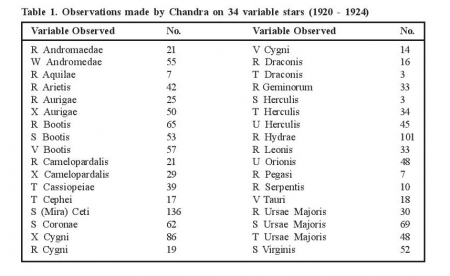
বকচর এলাকার নতুন প্রজন্মের কেউই রাধাগোবিন্দকে চেনে না। প্রবীণরা গত হয়েছেন। সংখ্যালঘুদের কেউ কেউ ভারতে চলে গেছেন। অনেক খেঁজাখুঁজির পর জানা গেল শ্রীদাম বাবু রাধাগোবিন্দের সঙ্গে রাতের আকাশ দেখেছেন। তার বাড়ি রাধাগোবিন্দের বাড়ির সামনেই। বকচর এলাকার মন্দিরের পাশেই শ্রীদাম বাবুর বাড়ি। তার বয়স তখন ৯০ বছর। রাধাগোবিন্দ সম্পর্কে তিনি অনেক গুরুত্বপূর্ণ তথ্য দেন।
শ্রীদাম বাবু বলেন, “রাধাগেবিন্দ যশোর কালেক্টরেট অফিসের খাজাঞ্চি ছিলেন। আমি তখন ক্লাস সিক্সে পড়ি। সে সময় রাধা দাদা রাত জেগে তারা দেখতেন। তখন ঘন বসতি ছিল না। এলাকায় তিনটি সংস্কৃতি ক্লাব ছিল। সাহিত্য সম্মেলন, গানের অনুষ্ঠান লেগেই থাকতো। দাদা শিশুদের খুব ভালবাসতেন। আমাদের বাড়ির ছাদে টুলের ওপর দাঁড় করিয়ে দূরবীনে চোখ লাগিয়ে দিতেন। কতো তারা দেখেছি তার কোন হিসাব নেই। ভাদ্র মাসে আকাশ পরিষ্কার থাকলে তাঁর খাওয়া দাওয়া থাকতো না শুধুই রাতের আকাশ দেখা ছাড়া। পৃথিবীর ফাস্ট প্রাইজ তিনি পেয়েছিলেন। আমেরিকা সরকার তাঁকে দূরবীন উপহার দিয়েছিল। গোবিন্দ দাদা নিজেও জমি বিক্রি করে দূরবীন কিনেছিলেন। অবসর জীবনযাপনের সময়ও তিনি তারা দেখেছেন। পেনশনের টাকা তুলতে গেলে কালেক্টরেটের কর্মকর্তাদের সঙ্গে তার বাচসা হয়। কর্মকর্তারা তাঁকে ভারতে চলে যেতে বলেন। তখন ডিসি ছিলেন এম. আর কুদ্দুস। ১৯৬০ সালের দিকে হবে। গোবিন্দ মাইগ্রেশন চান। এক পর্যায়ে দূরবীন নিয়ে ভারতে যাত্রা করেন। বেনাপোলে তার দূরবীন কাস্টমস সিজ করে। পরে আমেরিকা, ফ্রান্সের সঙ্গে গোবিন্দ যোগাযোগ করেন। ডিসি বাড়ি এসে দূরবীনটি ফেরৎ দিয়ে যান। পরে গোবিন্দ দূরবীন নিয়ে ভারতে বারাসাতে গিয়ে বসবাস শুরম্ন করেন। স্বাধীনতার পর গোবিন্দের ছেলে কালু, মেয়ে বর্ষা বকচরে কয়েকবার এসেছিল। কিন্তু তাদেরকে কেউ সাহায্য করেনি। শ্রীদাম বাবু আরো জানালেন, ২০/২৫ বছর আগে ফ্রান্স থেকে একদল লোক এসেছিলেন ফ্রান্সে কনফারেন্স করার জন্য রাধাগোবিন্দকে নিতে। কিন্তু তিনি তো মারা গেছেন। তারা ঠিকানা নিয়ে গেছেন। বাড়ীর ছবি তুলে নিয়ে গেছেন। আমরা কেউ তাকে স্মরণ করি না। তবে শুনেছি ভারতে তার জন্ম ও মৃত্যুবার্ষিকী উৎসবের উদযাপিত হয়।”
আব্দুল কাদেরের বয়স এখন ৮৮ বছর। তিনি বকচর এলাকার একজন প্রবীণ ব্যক্তি। রাধাগোবিন্দ চন্দ্র সম্পর্কে আব্দুল কাদের বললেন, “রাধা সারা রাত জেগে তারা দেখতো। আমরা মাঝে মধ্যে হাজারি ঠাকুরের বাড়ী থেকে রাধার আহবানে তারা দেখার জন্য যেতাম। কালেক্টরেট অফিসের খাজাঞ্চির চাকরি করে বাড়ী ফিরে সন্ধ্যা থেকেই রাধা আকাশের দিকে তাকিয়ে থাকতো। বিলেত থেকে তাঁকে তারা দেখার জন্য দূরবীন দেওয়া হয়েছিল। আইয়ুব খানের আমলে রাধা পরিবারের সবাইকে নিয়ে ভারতে বারাসাতে চলে যায়। তারপর আর তাঁর সঙ্গে দেখা হয়নি। শুনেছি রাধার বাড়ি রোকন দারোগা রিকুজিশন করে নিয়েছে। রাধা বকচরের গর্ব ছিল। কারো সঙ্গে জোরে কথা বলেনি। শুধু তারা দেখার কথাই বলেছে।”
কোন রকম প্রথাগত ডিগ্রী ও প্রশিক্ষণ, জ্যোতিবিজ্ঞান গবেষণার জন্য উপযুক্ত মানমন্দির ও যন্ত্রপাতি, এই সব না থাকলেও কেবলমাত্র অদম্য কৌতুহল, ইচ্ছাশক্তি, নিষ্ঠা ও অপরিসীম অধ্যবসায়কে সম্বল করে যে উঁচুমানের বিজ্ঞান গবেষণা করা সম্ভবপর রাধাগোবিন্দ তার এক উজ্জ্বল দৃষ্টান্ত।
আজ খুব দুঃখ লাগে যে, আমাদের দেশের এই বরেণ্য বিজ্ঞান সাধকের যথাযথ মূল্যায়ন হয়নি। বাংলাদেশের কোনো ব্যক্তি, কোন সংগঠন স্মরণ করার খবর পাওয়া যায়নি। এমন কি অনেকেই যশোহর জেলার এই বিজ্ঞান সাধকের নামও জানে না।
সরেজমিন যশোরের বকচার এলাকায় শত মানুষের কাছে খবর নিয়েও তাঁর সম্পর্কে কোনো তথ্য জানা যায়নি। দু’একজন প্রবীণ ব্যক্তি রাধার আকাশ দর্শনের কথা বলেছেন। কিন্তু বিস্তারিত জানাতে পারেননি। দেশ ভাগের পর একরকম রাধাগোবিন্দ চন্দ্র অভিমান করেই ভারতে চলে যায়। স্থানীয় প্রবীণদের কাছেই জানা যায়, তিনি তার বাড়িটি বিক্রি করেও যাননি।
নূর মোহাম্মদ নামের এক ব্যক্তি শত্রু সম্পত্তি হিসেবে ডিসি আর কেটে রাধা গোবিন্দের বাড়িতে বসবাস শুরু করেন। এরপর এই বাড়ির মালিক হন পুলিশের একজন অবসরপ্রাপ্ত কর্মকর্তা রোকন দারোগা। এখন এ বাড়ির লোকরাও রাধা গোবিন্দ চন্দ্রকে চেনেন না।
বাংলাদেশে জীবনের অধিকাংশ সময় কাটালেও ১৯৪৭-এ ভারত বিভাগের পরে পাকিস্তান ও ভারত সৃষ্টির কিছুকাল পর তিনি ভারতে চলে যান। প্রত্যক্ষদর্শীর বর্ণনা মতে তিনি ১৯৬০সালে ভারতে যান। এসময় তিনি অবসর জীবনযাপন করছিলেন। যশোরের তৎকালীন জেলা কমিশনার এম.আর. কুদ্দুস সহ অন্যান্য সরকারি কর্মকর্তারা তাকে ভারতে চলে যেতে বলেছিলেন। মার্কিন সরকার তাকে একটি দূরবীন উপহার দিয়েছিলো। এছাড়া তিনিও জমি বিক্রি করে একটি দূরবীন কিনেছিলেন। ভারতে যাবার সময় তিনি দূরবীন নিয়ে যান। কিন্তু বেনাপোল বন্দরে কাস্টম্স তার দূরবীন জবরদস্ত করে। এরপর ভারতে যেয়ে তিনি আমেরিকা ও ফ্রান্স সরকারের সাথে যোগাযোগ করেন। পরে যশোরের জেলা প্রশাসক নিজে গিয়ে তার বাড়িতে টেলিস্কোপটি তাকে ফেরত দিয়ে আসেন।
ভারতে যাওয়ার পর তিনি যথেষ্ট আর্থিক দুরবস্থার মধ্যে পড়েন। বারাসাতের দুর্গাপল্লীতে ১৯৭৫ সালের ৩ এপ্রিল ৯৭ বছর বয়সে প্রায় বিনা চিকিৎসায় তিনি মারা যান। মৃত্যুর সময় তার প্রায় সমস্ত বইপত্র এবং তিন ইঞ্চির সেই দূরবীক্ষণ যন্ত্রটি তিনি দান করে দিয়ে যান বারাসাতের সত্যভারতী বিদ্যাপীঠে। এলমারের দেওয়া টেলিস্কোপটি তার মৃত্যুর পরে দক্ষিণ ভারতীয় জ্যোতির্বিদ ভেইনু বাপ্পুর কাছে কিছুদিন থাকার পর এখন পরম যত্নে রাখা আছে দক্ষিণ ভারতের কাভালুর মানমন্দিরে।
মৃত্যুর আগ পর্যন্ত তিনি এ দেশে পান নি বিশেষ কোনো সম্মাননা, পান নি বিশেষ কোনো পরিচিতি। “বৈজ্ঞানিক অচিরেই কোন লাভের সম্ভাবনা আছে বলিয়া জ্ঞানানুশীলন করেন না। তিনি বিশুদ্ধ জ্ঞানলাভের জন্য নিঃস্বার্থ-ভাবে লোকের প্রশংসা বা নিন্দা অগ্রাহ্য করিয়া, একান্ত বিনম্রভাবে সাধনা করিয়াই আনন্দ পান।” (বৈজ্ঞানিকের জ্ঞানসাধন, কাজী মোতাহার হোসেন)
রাধাগোবিন্দ চন্দ্র এমনই এক চরিত্র। প্রচলিত লাভের হিসাব নিকাশ ছেড়ে আজীবন তিনি একান্ত বিনম্রভাবে সাধনারত ছিলেন। এজন্যই এ চরিত্র নবীন প্রজন্মের কাছে অনুসরণীয় ও অনুকরণীয়।
REFERENCES
1. Ranatosh Chakrabarty, ‘Jyotirbijnani Radhagobinda’ (Puthipatra, Kolkata, 1999).
2. Radhagobinda Chandra, ‘Dhumketu’ (Puthipatra, Kolkata, 1985).
3. Catalogue of Cometary Orbits (eds. B. C. Marsden and C. V. Williams), Smithsonian
Astrophysical Observatory, Cambridge, U.S.A. (1999).
4. Nature, Vol. 107, No. 2700, p. 694 (1921).
28
5. Monthly Reports and Annual Reports of the American Association of Variable Star Observers, p. 133 (1926).
6. Memoirs of the British Astronomical Association, vol. XXVIII, Table C. (1929).
7. Rajesh Kochhar and Jayant Narlikar, ‘Astronomy in India: Past, Present and Future’
(IUCAA, Pune and IIA, Bangalore, 1993).
8. Astronomy of the 20th Century : Otto Struve and Velta Zeberss (Macmillan Co., New
York, p. 354, 1962).
9. Journal of the British Astronomical Association 34, 241.
10. Ibid, 42, 178.
11. Ibid, 44, 157.
12. Ibid, 45, 407.
13. Modern Review (June, 1971, pp 445-449).
14. Amulya Bhusan Gupta, ‘Nakshatrabid Radhagobinda’, ’swaksar’ (Barasat Satyabharati
vidyapith Magazine), p. 2-7 (1975).
15. Naimul Islam Apu, ‘Jyotirbid Radhagobinda Chandra’, Tamralipi, Dhaka - 1100, Bangladesh
(2008).
16. Arup Ratan Bhattacharya, ‘Radhagobinder Aprokasito Pandulipi’, Anandamela, 12 July
(1989).
17. Kalinath Mukherjee, ‘Popular Hindu Astronomy’, published by Nirmal Mukherjee, 18,
Deshapriyo Park, Kolkata - 700 026 (1905).
18. Nature, p. 105, 10 October (1918).
সর্বশেষ এডিট : ২০ শে মার্চ, ২০২১ রাত ১:২৯


 অনুগ্রহ করে অপেক্ষা করুন। ছবি আটো ইন্সার্ট হবে।
অনুগ্রহ করে অপেক্ষা করুন। ছবি আটো ইন্সার্ট হবে।.jpg)





